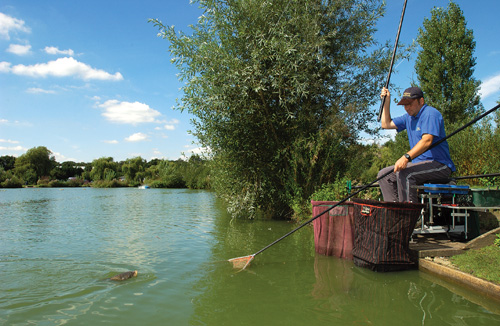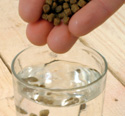Pellets are the most used bait on commercial waters, but do you understand them as well as you should? Find out all about the different varieties, including how to prepare expanders.
IF there’s one bait that reigns supreme over all others for commercial water fishing it has to be the mighty pellet, but why is this?
Fish intended for commercial waters are fed on pellets from fry size, so it’s a bait they’re familiar with from the start as they recognise them as a valuable food source. People cottoned on to this and soon began to approach commercial waters up and down the country with high oil trout pellets, but things have changed dramatically since the early days and there are now all sorts of different colours, sizes and flavours available, but do you understand what you’re using and why you’re using them?
Trout Vs Coarse
In the early days, when you talked about using pellets, the trout variety were what everyone would use, but suspicions soon arose that stated high oil trout pellets were in fact bad for fish as the oil within the bait made them very hard for carp and other coarse fish to digest.
This led to the development of low-oil ‘coarse’ pellets that are designed to be more fish-friendly than other varieties.
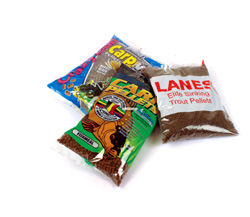 |
Different people seem to have their own theories on this subject, but a lot of commercial waters up and down the country banned the use of high oil pellets, meaning anglers were limited to coarse pellets only.
Many bait companies saw this and now produce very high-quality coarse pellets in all different sizes, flavours and colours.
But are the fancy ingredients there to catch more anglers than fish? Most coarse pellets contain 30 to 32 per cent protein and a much lower oil level of around eight per cent.
Coarse pellets are designed to supply a larger percentage of the fishes’ required protein through vegetable sources. A coarse pellet will usually be made of fishmeal, wheat, soya meal, corn product, fish oil, vitamins and minerals.
On average most trout pellets contain 40 to 42 per cent protein and 20 per cent fish oil. Some top quality pellets will contain anywhere between 44 to 46 per cent protein and up to 30 per cent oil. Some smaller pellets of less than 4mm often have higher protein levels of 50 to 54 per cent, but a lower oil content of around 18 to 26 per cent.
A typical 6mm top quality pellet will consist of the following ingredients. In descending percentage inclusion they are low temperature fishmeal, fish oil, corn product, wheat, soya meal, vitamins, minerals and an amino acid compound.
Carp will utilise any oil they consume to produce energy and fish will also use protein as an energy source, although in the presence of oils, proteins are spared and the protein is utilised to repair and create growth in fishes’ body tissue.
Halibut and Marine Pellets – What’s The Difference?
Halibut pellets are mainly used on the big carp scene, but they do have big advantages over standard pellets where they’re allowed. Halibut pellets are available in all different sizes, but of most use to match anglers are the 3mm to 6mm versions. Each pellet typically contains 46 to 56 per cent protein and 16 to 26 per cent oil, depending on the size of the pellet. Halibut pellets generally contain a few different ingredients to coarse and trout pellets, which is possibly what makes them so successful on the big carp scene. A typical halibut pellet contains low temperature fishmeal, fish oil, wheat, fish protein concentrate, crustacean meal, corn product, vitamins and minerals.
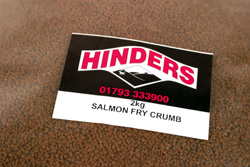 |
| Fry crumbs are made from very high quality ingredients. |
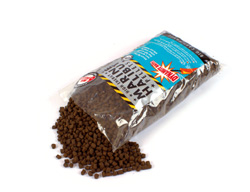 |
| Halibut pellets can be deadly, but are not allowed on many commercial waters. |
These pellets are made from higher quality ingredients and contain a more digestible protein source than those used in trout and coarse pellets.
They also have special palatability enhancers in them that most other pellets don’t, which helps make them attractive to more species of fish.
Some even include an immune system stimulant that help fish to fight off infections.
Fry Foods
These are used for feeding juvenile trout and other farmed species and range in size from fine powder form to around 1.8mm. These are generally higher in protein at around 50 per cent and lower in oil, averaging around 16 per cent. Fry crumbs are made of very high quality ingredients and therefore contain high protein levels to sustain the growth. Many anglers in the know use salmon fry crumb in their groundbaits to increase the protein levels and this can be especially effective on commercial waters where fish have seen pellet mixes time and time over.
Sizes
Pellets come in a few different shapes and in many different sizes to suit all different sizes of fish and different situations. They’re available in sizes from Micro, which are usually around 1/2mm in diameter through to huge 20mm-plus sizes for when you’re targeting real lumps. Of most use to the match angler, though, are the micro to 6mm sizes as the fish we target are generally between a few ounces and 10lb.
Believe us, the size of pellet you choose is critical and will make a massive difference to your catch rate.
Now, different people again have their own guidelines and there are certainly no hard and fast rules.
A good general guide to follow is the bigger the fish the bigger the pellet, sounds logical, but you really need to think about the size you’re using.
Pellet Size Carp Size
Micro 2oz to 3lb
2mm 1lb to 4lb
3mm 2lb to 5lb
4mm 3lb to 8lb
6mm 4lb to 9lb
8mm 10lb plus
10mm+ Leave ’em in the tackle shop
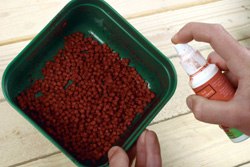 |
| Strawberry is a particularly good flavour to use with pellets. |
Flavours
To a lot of anglers, natural or fishmeal-type pellets are the number one choice, but a few bait companies have realised how good certain flavours are on different waters and have flavoured and coloured pellets to give you the edge. Strawberry seems to be a particularly good flavour, but there are many others out there and you can also flavour your own if you can’t get exactly what you need.
Flavouring pellets is very easy as all you have to do is flavour the water you soak your pellets in and give them time to fully absorb the flavour. Follow the step-by-step guide to see exactly how it’s done.
It’s also true that certain flavours work at different times of the year and a spicy, curry-flavoured pellet can work superbly when the water’s still warming up. Similarly, providing they’re allowed, a pellet with a higher oil content can be great in the height of summer as fish can digest baits far more easily in warmer water. Flavoured pellets are often accompanied by the associated colour and a lot of commercial waters respond well to a certain coloured bait. For example, waters that respond to red maggots can be successfully approached with red pellets. It’s all about experimentation and if you can suss a bait out that works quicker than anyone else who fishes the water, then you’re likely to catch a lot more fish.
Hook Baits
Because pellets are very hard in their raw state, it’s actually impossible to get a hook through them. However, there are a few ways to get around this and the first is to use a rubber bait band around the hard bait. You can then push the hook under the rubber band and away you go.
This is a particularly good method when you’re fishing shallow because you can constantly lift and drop the bait without it falling off, which can be a problem with soft, hookable pellets. There are a few devices on the market that will help you to place bait bands around the pellets as it can be quite a fiddly job. Korum market a bait bander that does the job perfectly as does John Roberts, but it’s dead easy to make your own out of a ‘chubber’ type river float (follow the sequence).
The second way to present a hook bait is to hair-rig the baits. This is very easy to do, but you’ll need a drill, a baiting needle and some hair stops. However, for feeder fishing a hair-rigged bait can’t be rivalled (follow the sequence).
If you’re speed fishing then there is another way that is 10 times quicker and that’s to glue pellets to an elastic band. You then just cut one pellet off when you need it and push the hook through the rubber band. This method is best for fishing shallow or times when you’re catching very quickly and need to get a hookbait in the water as quickly as possible.
The last, and ultimately the best way, is to use expander pellets as hook baits. Expanders are floating pellets which are very hard in their raw, unprepared state. You have to soak expander pellets in water and give them time to soften before you can hook them. There are a few different ways of preparing expanders, and here are two, one with a pellet pump, and on without.
Preparing Expanders Without A Pump
|
|
||||
|
|
Preparing Expanders Without A Pump
|
|
||||
|
|
Crunch Time
Other hard baits like hemp seed and snails, found naturally in lakes, are very attractive to carp simply because they seem to like to crunch baits as they eat, so it’s worth baring this in mind for your pellet fishing. Regular feeding via a pole pot is the best way to constantly introduce hard pellets to the swim, but a lot of other anglers believe soft, soaked pellets are better, so who’s right?
Is it more down to personal choice and whatever the fish in your local waters are used to? Experimentation is without doubt the key.


